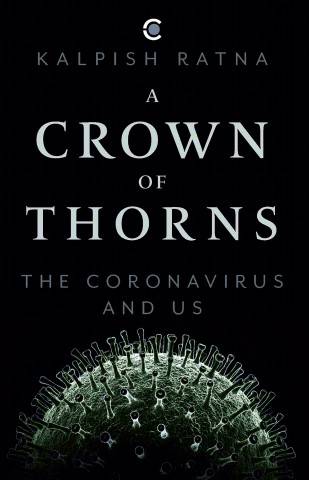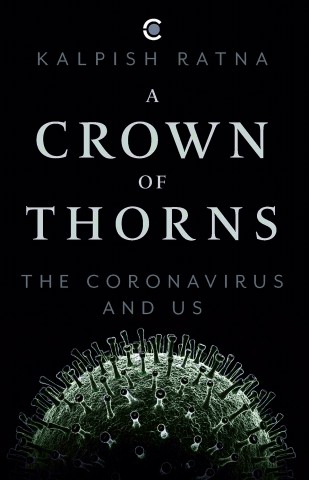
"Like all great stories, COVID-19 is a tragedy, a love story gone seriously wrong.”
Sometime in November 2019, China reported the first suspected case of the novel Coronavirus. On 31 December 2019, an epidemiological alert was issued. A year later, today, the whole world is grappling with this deadly virus, in some form or other. While some countries are currently facing the second or the third wave or fresh cases being registered, some are discovering the long-term effects of the virus. Approximately 1.5 million people have died in this pandemic globally.
Surgeons Ishrat Syed and Kalpana Swaminathan write together as “Kalpish Ratna.” They have previously written a book on the Zika Virus (2017). Bringing together their experiences and expertise in the medical field, they analyze the deadly pandemic which has brought the whole world to a standstill.
This 250-pager book tries to not only demystify the Coronavirus but also attempts to give us hope by showing us how to deal with it. Neatly divided into 39 chapters, the book dissects the virus from every aspect. From the how, what, when, where and why to the more detailed analysis on what next, how to deal with it, what all can we expect etc. - this book covers it all at length.

Though the topic is daunting, the language of the book is extremely lucid and conversational. Written in first person by the doctors, they trace the origins of the first case and go on to expand further on how it turned into a full-blown global pandemic.
Novel coronavirus, COVID-19, SARS-CoV-2 or Coronavirus - the deadly virus might have been referred to by different names but the impact is familiar to all. Economies impacted, lives lost, families separated, jobs lost – the amount of destruction caused by this pandemic is surmountable. And yet, even a year later, we are yet to see any respite from the surprises it keeps sending our way in the form of new symptoms, new side effects (found in recovered cases) etc.
Interestingly, according to Ratna, COVID-19 was no surprise and it was only a matter of time before this happened. As Ratna asks in the book, “Why did we let it happen again?” Simply because we refused to see the pattern and recognize the fatal impact it could have.
Backed with statistics, data, graphs and scientific explanations, A Crown of Thorns is a revelation in every form. For starters they clarify how even though the first outbreak was reported from Wuhan, it doesn’t mean the virus necessarily emerged there.

Which further leads to the most controversial question they have answered: Was it really caused by bats?
Their answer is,
“Many emerging diseases, like those listed above, are zoonoses – diseases transferred from other vertebrates. Their origins can usually be traced to wildlife. COVID-19 started this way too. Even if we haven’t yet traced its origins, we’ve known for years that coronaviruses circulate in bats.” (Pg. 10)
The book is interspersed with personal observations about everything and anything that got impacted due to Covid-19. Country=level precautionary measures, local political decisions, personal challenges, infrastructural challenges faced by countries and cities, economic differences suddenly thrown into sharp relief – this pandemic really changed the way we looked at things or, maybe at life itself!
In the 21st century, South Asian countries at large are known to have two major challenges – population and infrastructure. Coronavirus hit these two, making them worse. In countries like India, Pakistan, Bangladesh and Sri Lanka space has always been a constraint. A majority of the population lives in small houses, cramped with other members. In such living conditions, trying to maintain the basic norms of precautionary measures for Covid-19 – that of social distancing and self-isolation (in case you got infected or developed some symptoms) was a huge challenge. Moreover, given the sheer numbers of the population, implementation of any measures by the government was a task in itself. Spreading awareness was an uphill task as a majority of the population was of a class who were uneducated, with almost no access to digital platforms for information or knowledge. Chaos and confusion ruled the roost for the initial 3-4 months, with rumors floating around on social media leading to great fear amongst people.
The observations shared by Ratna on these socio-economic challenges are edifying. Instead of adding to the gloom, they are focused on ensuring the reader is well aware and well-equipped to face the uncertainty of future in this pandemic. Haunting images of deserted streets, people dying a lonely death in hospitals, bursting hospital corridors, tired faces of the frontline workers, the camaraderie of absolute strangers trying to help each other survive this chaos, the fear of death, the sense of impending doom and the uncontrollable urge to scream – all of it has been captured brilliantly in this book.
Somewhere towards the end of the book, as the reality of it all threatens to overwhelm your senses, the authors’ words give you solace.
‘It is time to rethink Covid-19.
Think of it as autochthonous, existing in nature- not just in the bat but in one or innumerable intermediate hosts.
Think of it as disinclined to spill over.
Think of COVID-19 not as a killer disease but as an infection your body can resist.
Above all, think of COVID-19 as part of the filthy air we breathe.” (Pg. 207)
After completing this most timely book, one cannot help but wonder if it would be better to call this pandemic a rude wake-up call or a unique reminder from nature.
Namrata M is a writer and editor based in Mumbai
Sometime in November 2019, China reported the first suspected case of the novel Coronavirus. On 31 December 2019, an epidemiological alert was issued. A year later, today, the whole world is grappling with this deadly virus, in some form or other. While some countries are currently facing the second or the third wave or fresh cases being registered, some are discovering the long-term effects of the virus. Approximately 1.5 million people have died in this pandemic globally.
Surgeons Ishrat Syed and Kalpana Swaminathan write together as “Kalpish Ratna.” They have previously written a book on the Zika Virus (2017). Bringing together their experiences and expertise in the medical field, they analyze the deadly pandemic which has brought the whole world to a standstill.
This 250-pager book tries to not only demystify the Coronavirus but also attempts to give us hope by showing us how to deal with it. Neatly divided into 39 chapters, the book dissects the virus from every aspect. From the how, what, when, where and why to the more detailed analysis on what next, how to deal with it, what all can we expect etc. - this book covers it all at length.

Though the topic is daunting, the language of the book is extremely lucid and conversational. Written in first person by the doctors, they trace the origins of the first case and go on to expand further on how it turned into a full-blown global pandemic.
Novel coronavirus, COVID-19, SARS-CoV-2 or Coronavirus - the deadly virus might have been referred to by different names but the impact is familiar to all. Economies impacted, lives lost, families separated, jobs lost – the amount of destruction caused by this pandemic is surmountable. And yet, even a year later, we are yet to see any respite from the surprises it keeps sending our way in the form of new symptoms, new side effects (found in recovered cases) etc.
Interestingly, according to Ratna, COVID-19 was no surprise and it was only a matter of time before this happened. As Ratna asks in the book, “Why did we let it happen again?” Simply because we refused to see the pattern and recognize the fatal impact it could have.
Backed with statistics, data, graphs and scientific explanations, A Crown of Thorns is a revelation in every form. For starters they clarify how even though the first outbreak was reported from Wuhan, it doesn’t mean the virus necessarily emerged there.

Which further leads to the most controversial question they have answered: Was it really caused by bats?
Their answer is,
“Many emerging diseases, like those listed above, are zoonoses – diseases transferred from other vertebrates. Their origins can usually be traced to wildlife. COVID-19 started this way too. Even if we haven’t yet traced its origins, we’ve known for years that coronaviruses circulate in bats.” (Pg. 10)
Somewhere towards the end of the book, as the reality of it all threatens to overwhelm your senses, the authors’ words give you solace
The book is interspersed with personal observations about everything and anything that got impacted due to Covid-19. Country=level precautionary measures, local political decisions, personal challenges, infrastructural challenges faced by countries and cities, economic differences suddenly thrown into sharp relief – this pandemic really changed the way we looked at things or, maybe at life itself!
In the 21st century, South Asian countries at large are known to have two major challenges – population and infrastructure. Coronavirus hit these two, making them worse. In countries like India, Pakistan, Bangladesh and Sri Lanka space has always been a constraint. A majority of the population lives in small houses, cramped with other members. In such living conditions, trying to maintain the basic norms of precautionary measures for Covid-19 – that of social distancing and self-isolation (in case you got infected or developed some symptoms) was a huge challenge. Moreover, given the sheer numbers of the population, implementation of any measures by the government was a task in itself. Spreading awareness was an uphill task as a majority of the population was of a class who were uneducated, with almost no access to digital platforms for information or knowledge. Chaos and confusion ruled the roost for the initial 3-4 months, with rumors floating around on social media leading to great fear amongst people.
The observations shared by Ratna on these socio-economic challenges are edifying. Instead of adding to the gloom, they are focused on ensuring the reader is well aware and well-equipped to face the uncertainty of future in this pandemic. Haunting images of deserted streets, people dying a lonely death in hospitals, bursting hospital corridors, tired faces of the frontline workers, the camaraderie of absolute strangers trying to help each other survive this chaos, the fear of death, the sense of impending doom and the uncontrollable urge to scream – all of it has been captured brilliantly in this book.
Somewhere towards the end of the book, as the reality of it all threatens to overwhelm your senses, the authors’ words give you solace.
‘It is time to rethink Covid-19.
Think of it as autochthonous, existing in nature- not just in the bat but in one or innumerable intermediate hosts.
Think of it as disinclined to spill over.
Think of COVID-19 not as a killer disease but as an infection your body can resist.
Above all, think of COVID-19 as part of the filthy air we breathe.” (Pg. 207)
After completing this most timely book, one cannot help but wonder if it would be better to call this pandemic a rude wake-up call or a unique reminder from nature.
Namrata M is a writer and editor based in Mumbai

